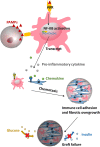Polymeric Approaches to Reduce Tissue Responses Against Devices Applied for Islet-Cell Encapsulation
- PMID: 31214587
- PMCID: PMC6558039
- DOI: 10.3389/fbioe.2019.00134
Polymeric Approaches to Reduce Tissue Responses Against Devices Applied for Islet-Cell Encapsulation
Abstract
Immunoisolation of pancreatic islets is a technology in which islets are encapsulated in semipermeable but immunoprotective polymeric membranes. The technology allows for successful transplantation of insulin-producing cells in the absence of immunosuppression. Different approaches of immunoisolation are currently under development. These approaches involve intravascular devices that are connected to the bloodstream and extravascular devices that can be distinguished in micro- and macrocapsules and are usually implanted in the peritoneal cavity or under the skin. The technology has been subject of intense fundamental research in the past decade. It has co-evolved with novel replenishable cell sources for cure of diseases such as Type 1 Diabetes Mellitus that need to be protected for the host immune system. Although the devices have shown significant success in animal models and even in human safety studies most technologies still suffer from undesired tissue responses in the host. Here we review the past and current approaches to modulate and reduce tissue responses against extravascular cell-containing micro- and macrocapsules with a focus on rational choices for polymer (combinations). Choices for polymers but also choices for crosslinking agents that induce more stable and biocompatible capsules are discussed. Combining beneficial properties of molecules in diblock polymers or application of these molecules or other anti-biofouling molecules have been reviewed. Emerging are also the principles of polymer brushes that prevent protein and cell-adhesion. Recently also immunomodulating biomaterials that bind to specific immune receptors have entered the field. Several natural and synthetic polymers and even combinations of these polymers have demonstrated significant improvement in outcomes of encapsulated grafts. Adequate polymeric surface properties have been shown to be essential but how the surface should be composed to avoid host responses remains to be identified. Current insight is that optimal biocompatible devices can be created which raises optimism that immunoisolating devices can be created that allows for long term survival of encapsulated replenishable insulin-producing cell sources for treatment of Type 1 Diabetes Mellitus.
Keywords: biocompatibility; encapsulation; host response; islet; polymer; surface properties; transplantation.
Figures





Similar articles
-
Enhancing longevity of immunoisolated pancreatic islet grafts by modifying both the intracapsular and extracapsular environment.Acta Biomater. 2023 Sep 1;167:38-53. doi: 10.1016/j.actbio.2023.06.038. Epub 2023 Jun 29. Acta Biomater. 2023. PMID: 37392934 Review.
-
Applying Immunomodulation to Promote Longevity of Immunoisolated Pancreatic Islet Grafts.Tissue Eng Part B Rev. 2022 Feb;28(1):129-140. doi: 10.1089/ten.TEB.2020.0326. Epub 2021 Feb 24. Tissue Eng Part B Rev. 2022. PMID: 33397201 Review.
-
Treatment of diabetes with encapsulated islets.Adv Exp Med Biol. 2010;670:38-53. doi: 10.1007/978-1-4419-5786-3_5. Adv Exp Med Biol. 2010. PMID: 20384217 Review.
-
Considerations for successful transplantation of encapsulated pancreatic islets.Diabetologia. 2002 Feb;45(2):159-73. doi: 10.1007/s00125-001-0729-x. Diabetologia. 2002. PMID: 11935147 Review.
-
Evaluation of graft-host response for various tissue sources and animal models.Ann N Y Acad Sci. 1999 Jun 18;875:233-54. doi: 10.1111/j.1749-6632.1999.tb08507.x. Ann N Y Acad Sci. 1999. PMID: 10415571
Cited by
-
Recent Advances in Micro-Electro-Mechanical Devices for Controlled Drug Release Applications.Front Bioeng Biotechnol. 2020 Jul 29;8:827. doi: 10.3389/fbioe.2020.00827. eCollection 2020. Front Bioeng Biotechnol. 2020. PMID: 32850709 Free PMC article. Review.
-
Nanoparticle contrast-enhanced computed tomography and magnetic resonance imaging of vascularization of a subcutaneous niche for islet transplantation.Bioeng Transl Med. 2024 Dec 13;10(3):e10740. doi: 10.1002/btm2.10740. eCollection 2025 May. Bioeng Transl Med. 2024. PMID: 40385531 Free PMC article.
-
Optimal Time to Ship Human Islets Post Tissue Culture to Maximize Islet.Cell Transplant. 2020 Jan-Dec;29:963689720974582. doi: 10.1177/0963689720974582. Cell Transplant. 2020. PMID: 33231091 Free PMC article.
-
Modeling of a Bioengineered Immunomodulating Microenvironment for Cell Therapy.Adv Healthc Mater. 2025 Feb;14(5):e2304003. doi: 10.1002/adhm.202304003. Epub 2024 Jan 20. Adv Healthc Mater. 2025. PMID: 38215451 Free PMC article.
-
Pancreatic stellate cells support human pancreatic β-cell viability in vitro and enhance survival of immunoisolated human islets exposed to cytokines.Mater Today Bio. 2024 Jun 18;27:101129. doi: 10.1016/j.mtbio.2024.101129. eCollection 2024 Aug. Mater Today Bio. 2024. PMID: 39022526 Free PMC article.
References
Publication types
LinkOut - more resources
Full Text Sources
Miscellaneous

